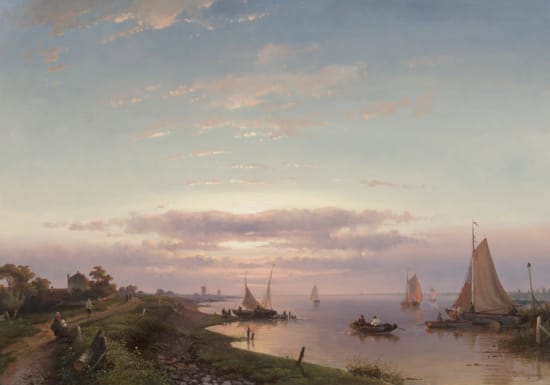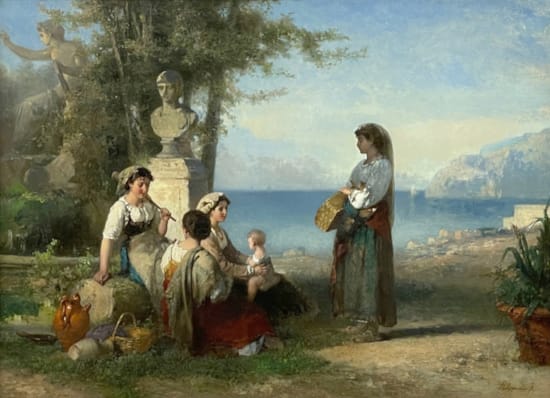Laurits Andersen Ring
(1854 - 1933)
Harvest time, Ladby
Signed and dated, lower right: LA Ring 30/8
Painted in 1892
Oil on canvas
28¾ x 39¼ in – 73 x 100 cm
Frame size
36½ x 47¼ in – 92.7 x 120 cm
Painted in 1892
Oil on canvas
28¾ x 39¼ in – 73 x 100 cm
Frame size
36½ x 47¼ in – 92.7 x 120 cm
Tel.: +44 (0)20 7839 7693
Provenance
Chr. Larsen, 1917;
Private collection, Denmark;
MacConnal-Mason Gallery, London;
Private collection, USA
Private collection, Denmark;
MacConnal-Mason Gallery, London;
Private collection, USA
Biography
Lauritz Andersen Ring was born in the village of Ring in South Zealand, Denmark on 15th August 1854. He was to become one of the finest Danish painters of his generation, a golden generation that established Danish painting in the eyes of the world, numbering amongst his contemporaries his friend Harmmershoi (1864-1916), Holsoe (1863-1935), Ilsted (1861-1933) and Monsted (1859-1941).
Ring was apprenticed as a painter 1868-72 before graduating from the Copenhagen Technical School in 1874 and subsequently enrolling at the Academy of Fine Arts. Ring was to become a painter who portrayed above all peasant life in rural Denmark, the subject for which he was to become renowned. He made his debut at Charlottenborg in 1882 and continued to exhibit there until 1928. Like many of his contemporaries, Ring travelled widely, between 1893 and 1895 he embarked on a tour of Europe visiting Germany, Holland, Belgium, France and Italy, returning to Italy in the early years of the twentieth century. A highly successful painter, Ring exhibited throughout Europe receiving an honourable mention at the Universal Exposition in Paris in 1889 and a bronze medal in 1900, he exhibited in Berlin, Dresden, where he was awarded a gold medal in 1897, a feat he repeated in Munich in 1901, and also exhibited in Chicago in 1893, London, Rome, New York, Malmo, Brooklyn, Paris and Venice in the early twentieth century.
Ring’s landscape and his portrayal of life in rural peasant communities was significantly influenced by the work of Bastien Lepage, the French social realist and the same lack of sentimentality pervades Ring’s work. That Ring adopted the name of the village of his birth is further evidence of his close identification with the land and rural life.
His works can be found in museums in: Aalborg; Aarhus; Copenhagen; Esbjerg; Randers; Storstroms; Gothenberg; Stockholm and Oslo
Ring was apprenticed as a painter 1868-72 before graduating from the Copenhagen Technical School in 1874 and subsequently enrolling at the Academy of Fine Arts. Ring was to become a painter who portrayed above all peasant life in rural Denmark, the subject for which he was to become renowned. He made his debut at Charlottenborg in 1882 and continued to exhibit there until 1928. Like many of his contemporaries, Ring travelled widely, between 1893 and 1895 he embarked on a tour of Europe visiting Germany, Holland, Belgium, France and Italy, returning to Italy in the early years of the twentieth century. A highly successful painter, Ring exhibited throughout Europe receiving an honourable mention at the Universal Exposition in Paris in 1889 and a bronze medal in 1900, he exhibited in Berlin, Dresden, where he was awarded a gold medal in 1897, a feat he repeated in Munich in 1901, and also exhibited in Chicago in 1893, London, Rome, New York, Malmo, Brooklyn, Paris and Venice in the early twentieth century.
Ring’s landscape and his portrayal of life in rural peasant communities was significantly influenced by the work of Bastien Lepage, the French social realist and the same lack of sentimentality pervades Ring’s work. That Ring adopted the name of the village of his birth is further evidence of his close identification with the land and rural life.
His works can be found in museums in: Aalborg; Aarhus; Copenhagen; Esbjerg; Randers; Storstroms; Gothenberg; Stockholm and Oslo




